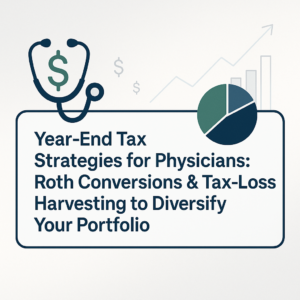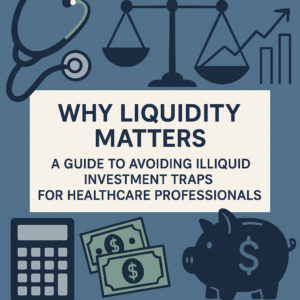According to the Association of American Medical Colleges, the average medical student graduates with over $200,000 in student loan debt. This massive amount highlights the urgent need for smart financial planning. This comprehensive guide will explore essential strategies for managing and optimizing debt, ensuring a secure and prosperous financial future for healthcare professionals.
Understanding Your Debt
To manage your debt effectively, it’s crucial to understand the various types of debts you may have. As a healthcare professional, you might be dealing with student loans, business loans, and personal loans. Understanding the terms and interest rates of each debt can help you create a strategic repayment plan.
Types of Debts
Student Loans
Many healthcare professionals accumulate substantial debt during their education. These loans often come with different interest rates and repayment terms, which can significantly impact your financial stability.
Typical Interest Rates
Federal student loans usually have fixed interest rates ranging from 2.75% to 8%, while private student loans can vary from 3% to 12% based on creditworthiness.
Repayment Options
Federal loans offer various repayment plans, such as income-driven repayment plans, which adjust your monthly payment based on your income. Private loans may offer less flexibility.
Business Loans
If you own or plan to start a practice, business loans can provide the necessary capital for equipment, office space, and staff. Understanding the terms of these loans is essential for efficient debt management.
Typical Interest Rates
Business loan interest rates can range from 3% to 18% depending on the lender and your credit profile.
Repayment Terms
Business loans often have fixed monthly payments over a term that can vary from a few months to several years.
Personal Loans
Personal loans can be used for various purposes, such as consolidating other debts, covering emergency expenses, or funding major purchases. The terms of personal loans can vary widely, making it important to review and understand the interest rates and repayment schedules.
Typical Interest Rates
Personal loan interest rates usually range from 5% to 36%, depending on your credit score and other factors.
Repayment Terms
These loans typically offer repayment periods from one to seven years.
Categorizing Debts
Prioritize High-Interest Debt
Identify which debts have the highest interest rates. Paying off these debts first can save you money in the long run because it reduces the amount of interest you’ll accrue over time.
Short-Term vs Long-Term Loans
Understand the differences between short-term and long-term loans. Short-term loans usually have higher monthly payments but can be paid off quicker, whereas long-term loans spread payments over a longer period, reducing your monthly burden but potentially increasing the total interest paid.
Fixed vs Variable Rates
Determine whether your loans have fixed or variable interest rates. Fixed rates remain the same throughout the loan term, while variable rates can change based on market conditions. This can impact your monthly payments and overall interest costs.
Tools for Debt Management
Debt Avalanche vs. Debt Snowball Methods
Use these strategies to prioritize debt repayment. The Debt Avalanche method focuses on paying off high-interest debts first, while the Debt Snowball method targets smaller balances to build momentum.
Debt Tracking Apps
Apps like Mint, YNAB (You Need A Budget), and Quicken can help you categorize and manage your debts efficiently.
Loan Amortization Calculators
Use online tools to calculate the amortization schedule for each loan, helping you understand how much of each payment goes toward principal and interest.
Refinancing for Better Terms
Refinancing is a powerful tool for healthcare professionals looking to manage and optimize debt. It involves replacing an existing loan with a new one that has better terms, such as a lower interest rate, longer repayment period, or both. Here, we’ll discuss the benefits of refinancing and what to consider when looking for refinancing options.
Advantages of Refinancing
- Lower Interest Rates: One of the primary reasons to refinance is to secure a lower interest rate. This can reduce your monthly payments and the total amount of interest you pay over the life of the loan.
- Extended Repayment Terms: Refinancing can also allow you to extend the repayment period of your loan, which can lower your monthly payments and provide more financial flexibility.
- Consolidation of Debts: If you have multiple loans, refinancing can consolidate them into a single loan with one monthly payment. This simplifies your financial management and can lead to better terms overall.
What to Look for in Refinancing Options
- Interest Rate (APR): The Annual Percentage Rate (APR) encompasses both the interest rate and any related fees. Look for a lower APR to reduce your overall cost.
- Loan Term: Consider the length of the loan term. While longer terms can lower your monthly payments, they may also increase the total interest paid over time.
- Fixed vs Variable Rates: Decide whether a fixed or variable rate loan is more advantageous for your situation. Fixed rates offer stability, while variable rates might offer lower initial rates with the potential for future increases.
- Fees and Penalties: Be aware of any fees associated with refinancing, such as origination fees, application fees, or prepayment penalties. These can affect the overall savings you gain from refinancing.
Potential Pitfalls of Refinancing
- Watch out for hidden fees that can negate the savings from a lower interest rate.
- Ensure the new loan terms are actually better than your existing terms.
- Be cautious of extending the loan term too much, as this can increase the total interest paid over time.
Practical Tips for Refinancing
- Shop Around: Don’t settle for the first refinancing offer you receive. Compare rates and terms from multiple lenders to find the best deal.
- Consider Credit Unions and Online Lenders: Credit unions and online lenders often offer competitive rates and terms compared to traditional banks.
- Use an Online Calculator: Utilize online refinancing calculators to estimate potential savings and compare different loan scenarios.
Budgeting for Liquidity
Maintaining liquidity is crucial for managing both expected and unexpected expenses. Creating and sticking to a budget can help you ensure that you have enough cash flow to cover your needs while paying down debt.
Emergency Fund
An emergency fund is essential for covering unexpected costs, such as medical emergencies, car repairs, or sudden loss of income. Aim to save three to six months’ worth of living expenses in an easily accessible account.
Operational Needs
For those running their own practices, maintaining liquidity ensures that you can handle operational expenses, such as salaries, supplies, and utilities, without needing to rely on credit.
Practical Budgeting Tips
- Set Clear Monthly Budgets: Determine your monthly income and expenses. Categorize expenses into essential and non-essential to better understand areas where you can cut costs.
- Prioritize Essential Expenses: Focus on covering your essential expenses first, such as rent/mortgage, utilities, groceries, and minimum loan payments.
- Automate Savings: Set up automatic transfers to your savings or emergency fund account to ensure consistent contributions.
Enhancing Your Credit Score
A strong credit score is crucial for obtaining favorable refinancing terms, lower interest rates, and better financial opportunities. Here are steps you can take to improve your credit score and maintain good credit health.
Practical Steps to Boost Your Credit Score
- Make Pre-Emptive Credit Card Payments: Paying off your credit card balances before the statement closing date can reduce your credit utilization ratio and positively impact your score.
- Request Higher Credit Limits: Contact your credit card issuers to request higher credit limits. This can lower your credit utilization ratio as long as you don’t increase your spending.
- Pay Bills on Time: Consistently paying your bills on time is one of the most important factors in maintaining a strong credit score.
- Monitor Your Credit Report: Regularly review your credit report for errors. Dispute any inaccuracies that could negatively impact your score.
Importance of a Strong Credit Score
- Better Loan Terms: Lenders offer better terms, such as lower interest rates, to individuals with higher credit scores.
- Increased Credit Limit: A higher score can lead to higher credit limits, providing you with more financial flexibility.
- Rental and Employment Opportunities: Landlords and employers may check credit scores as part of their screening process.
Dive Deeper into Credit Score Calculation
- Payment History (35%): The record of your on-time payments versus late or missed payments.
- Credit Utilization (30%): The ratio of your credit card balances to your credit limits.
- Length of Credit History (15%): The age of your oldest account and the average age of all your accounts.
- New Credit (10%): The number of recent credit inquiries and newly opened accounts.
- Credit Mix (10%): The variety of credit types you have (e.g., credit cards, mortgages, installment loans).
Rebuilding Damaged Credit
- Secure Credit Cards: Use a secured credit card with a small limit to rebuild your credit history.
- Debt Repayment Plans: Set up a debt repayment plan to address overdue accounts.
- Credit Counseling: Seek assistance from credit counseling services to develop a plan for improving your credit score.
Leveraging Financial Services
Using financial services and platforms can provide healthcare professionals with the tools needed to identify the best loan options and stay informed about market trends.
Online Lenders
- Advantages: Quick application processes, often lower rates due to lower overhead costs.
- Limitations: Less personalized customer service, dependent on internet access.
Credit Unions
- Advantages: Member-focused, often competitive rates, localized service.
- Limitations: Membership restrictions, fewer technological advancements.
Traditional Banks
- Advantages: Established trust, broad range of services, in-person consultations.
- Limitations: Higher fees, longer processing times.
Checklist for Evaluating Financial Platforms
- Interest Rates: Compare the rates offered by different platforms.
- Fees and Penalties: Understand all associated fees.
- Repayment Terms: Evaluate the flexibility of repayment options.
- Customer Service: Check reviews or get testimonials about their customer service.
- Security and Privacy: Ensure the platform has strong data security measures.
Key Takeaways
- Understand Your Debt: Identify and categorize your different types of debts to prioritize repayment and optimize terms.
- Refinance for Better Terms: Lower your interest rates and payments through strategic refinancing decisions.
- Budget for Liquidity: Maintain enough liquidity to manage essential and unexpected expenses while paying down debt.
- Enhance Your Credit Score: Take actionable steps to improve your credit score and access better financial opportunities.
- Leverage Financial Services: Use financial platforms and stay informed about market trends to make smarter financial decisions.
By following these strategies, you can take control of your finances and ensure a secure and prosperous future. Start implementing these tips today and watch your financial health improve over time!
Disclaimer: Mainstay Capital is a registered investment advisor. This blog is for informational purposes only and does not constitute financial advice. Always consult with a qualified financial advisor for advice tailored to your specific financial situation.






